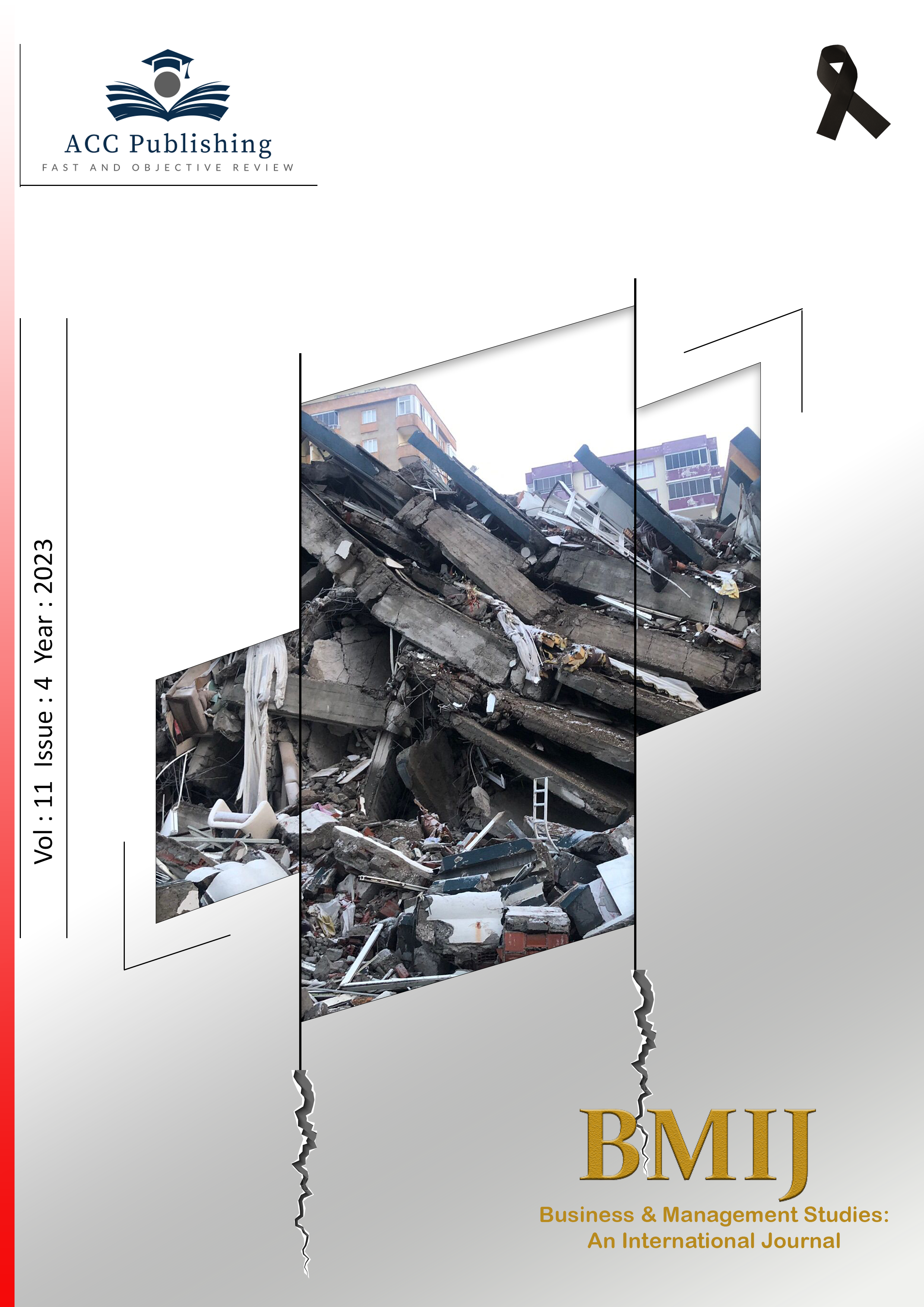
Published 2023-12-25
Keywords
- E-commerce, COVID-19 Pandemic, SWOT Analysis
- E-ticaret, COVİD-19 Pandemisi, SWOT Analizi
How to Cite
Copyright (c) 2023 Begüm Şahin

This work is licensed under a Creative Commons Attribution-NonCommercial-NoDerivatives 4.0 International License.
Abstract
This paper presents a SWOT Analysis to state Turkish E-Commerce activities' strengths, weaknesses, opportunities, and threats in the post-COVID-19 era. By examining the internal and external factors, the study aims to provide valuable insights for the whole actor, such as stakeholders, policymakers and businesses in the e-commerce ecosystem. As Türkiye has an important position among global actors, this study examines the key factors navigating the evolving landscape of e-commerce in Türkiye, both academically and practically. The analysis sheds light on strategic considerations associated with the market orientation approach to enhance the sector's resilience and assess the emerging opportunities in the aftermath of the pandemic.
Downloads
References
- Aslan, I., Çınar, O. and Özen, Ü. (2014). Developing strategies for the future of healthcare in Türkiye by benchmarking and SWOT analysis. Procedia-social and behavioural sciences, 150, 230-240.
- AMA (2017). Access address: https://www.ama.org/the-definition-of-marketing-what-is-marketing/
- Bayramoğlu, G. (2023). Access address: https://www.ntv.com.tr/ekonomi/pazaryeri-komisyonlari-saticilari-zorluyor,V6N6ALws5k28HRyQn-NbqA.
- Chakraborty, A., Shankar, R. and Marsden, J. R. (2022). An empirical analysis of consumerunfriendly E-commerce terms of service agreements: Implications for customer satisfaction and business survival. Electronic Commerce Research and Applications, 53, 101151.
- Denzin, N. K. and Lincoln, Y. S. (1998). The landscape of qualitative research: Theories and issues. Thousand Oaks: Sage.
- Digital 2023 (2023). Access address: https://wearesocial.com/uk/blog/2023/01/digital-2023/
- ETBİS (2023). Access address: https://www.eticaret.gov.tr/haberler/10094/detay
- Forbes (2023). Access address: https://www.forbes.com/advisor/business/ecommerce-statistics/
- Hamad, H., Elbeltagi, I. and El‐Gohary, H. (2018). An empirical investigation of business-to-business e‐commerce adoption and its impact on SMEs competitive advantage: The case of Egyptian manufacturing SMEs. Strategic Change, 27(3), 209-229. http://dx.doi.org/10.1002/jsc.2196.
- Holsapple, C. W. and Singh, M. (2000). Electronic commerce: from a definitional taxonomy toward a knowledge-management view. Journal of Organizational Computing and Electronic Commerce, 10(3), 149-170. http://dx.doi.org/10.1207/S15327744JOCE1003_01.
- Jang-Jaccard, J. and Nepal, S. (2014). A survey of emerging threats in cybersecurity. Journal of Computer and System Sciences, 80(5), 973-993. http://dx.doi.org/10.1016/j.jcss.2014.02.005.
- Koe, W.-L. and Afiqah Sakir, N. (trans.) (2020). The Motivation to Adopt E-commerce Among Malaysian Entrepreneurs. Organizations and Markets in Emerging Economies, 11(1), pp. 189–202. doi:10.15388/omee.2020.11.30. http://dx.doi.org/10.15388/omee.2020.11.30.
- Kohli, A. K. and Jaworski, B. J. (1990). Market Orientation: The Construct, Research Propositions, and Managerial Implications. Journal of Marketing, 54(2), 1. http://dx.doi.org/10.4135/9781452231426.n2.
- Kohli, A. K., Jaworski, B. J. and Kumar, A. (1993). MARKOR: a measure of market orientation. Journal of Marketing research, 467-477. http://dx.doi.org/10.1177/002224379303000406.
- Kotler, P., Kartajaya, H. and Setiawan, I. (2016), Marketing 4.0: moving from Traditional to Digital, John Wiley and Sons. http://dx.doi.org/10.1142/9789813275478_0004.
- Markovska, N., Taseska, V. and Pop-Jordanov, J. (2009). SWOT analyses of the national energy sector for sustainable energy development. Energy, 34(6), 752-756. http://dx.doi.org/10.1016/j.energy.2009.02.006.
- Miles, M. B., and Huberman, A. M. (1994). Qualitative data analysis: An expanded sourcebook. Sage.
- Narver, J. C. and Slater, S. F. (1990). The Effect of a Market Orientation on Business Profitability. Journal of Marketing, 20-35. http://dx.doi.org/10.4135/9781452231426.n3.
- Ocloo, C.E., Xuhua, H., Akaba, S., Shi, J. and Worwui-Brown, D.K. (2020). The determinant factors of business to business (B2B) E-commerce adoption in small- and mediumsized manufacturing enterprises. J. Glob. Inf. Technol. Manag, 23 (3), 191–216. https://doi.org/10.1080/1097198X.2020.1792229.
- Paypal (2023). Access address: https://tr.wikipedia.org/wiki/PayPal#:~:text=30%20May%C4%B1s%202016%20tarihinde%20resmi,yapt%C4%B1%C4%9F%C4%B1%20lisans%20ba%C5%9Fvurusunun%20reddedilmesi%20g%C3%B6sterildi.
- Ramanathan, R., Ramanathan, U. and Hsiao H.L., (2012). The impact of e-commerce on Taiwanese SMEs: marketing and operations effects. Int. J. Prod. Econ. 140 (2), 934–943. https://doi.org/10.1016/j.ijpe.2012.07.017.
- Reynolds, J. (2004). The complete e-commerce book: design, build and maintain a successful web-based Business. CRC Press. https://doi.org/10.1201/9781482295665.
- Ruekert, R. W. (1992). Developing a market orientation: an organizational strategy perspective. International journal of research in marketing, 9(3), 225-245. http://dx.doi.org/10.1016/0167-8116(92)90019-H.
- Saban, A. and Ersoy, A. (2019). Eğitimde nitel araştırma desenleri. Ankara: Anı
- Scriven, M. (1991). Evaluation thesaurus. Sage.
- Siber Suç Nedir? Bilişim Suçları Ve Cezaları Nelerdir?. (2023, April 5). Access address: https://www.ekinlaw.com/siber-suc-nedir-bilisim-suclari-ve-cezalari-nelerdir/
- Sila, I. (2019). Antecedents of electronic commerce in developing economies. Journal of Global Information Management (JGIM), 27(1), 66-92. http://dx.doi.org/10.4018/JGIM.2019010104.
- Statista (2023). Access address: https://www.statista.com/forecasts/1003041/most-popular-categories-for-online-purchases-in-Türkiye
- Şeker, Ş. and Özgürler, M. (2012). Analysis of the Turkish consumer electronics firm using SWOT-AHP method. Procedia-social and behavioural sciences, 58, 1544-1554. http://dx.doi.org/10.1016/j.sbspro.2012.09.1141.
- T.C. Ticaret Bakanlığı (2023). Access address: https://ticaret.gov.tr/destekler/e-ihracat-destekleri
- Thuy, D.N.H.T., (2022). Empirical research on the influence factors of e-commerce adoption among e-commerce companies in Vietnam. Global Changes and Sustainable Development in Asian Emerging Market Economies, Vol. 1 Proceedings of EDESUS 2019 (Issue January). https://doi.org/10.1007/978-3-030-81435-9〉.
- TÜBSİAD (2021). Access address: https://www.tubisad.org.tr/tr/images/pdf/tubisad-e commerce_impact_assessment-launchpresentation.pdf
- TÜİK (2023). Access address: https://www.tuik.gov.tr/
- TUMTİS (2022). Access address: https://tumtis.org/v2/2022/0908/moto-kurye-olumleri/
- Turkish E-commerce Ecosystem Outlook (2023). Access address: https://www.strategyand.pwc.com/tr/en/medya/turkiye-e-ticaret-ekosisteminingorunumu.html
- Türkiye E-ticaret Ekosistemi (2022). Access address: https://media.iyzico.com/b/2023/07/2022-e-ticaret-ekosistemi-raporu.pdf
- Türkiye’nin En Büyük E-ticaret Siteleri (2023). Access address: https://www.jetstok.com/blog/turkiyenin-en-buyuk-e-ticaret-siteleri#:~:text=Ara%C5%9Ft%C4%B1rmalar%20ilk%20s%C4%B1ralarda%20Trendyol%20ve,Bu%20s%C4%B1ralamay%C4%B1%20Gittigidiyor%20takip%20ediyor ,
- Vaurs, F. (2023). Access address: https://www.vaimo.com/blog/ecommercethreats/#:~:text=Common%20threats%20to%20ecommerce%20businesses,laws%2C%20and%20customer%20service%20issues
- Vijayaraman, B.S. and Bhatia, G. (2002). A framework for determining success factors of an Ecommerce initiative. J. Internet Commer. 1 (2), 63–75. https://doi.org/10.1300/ J179v01n02_05.
- World Bank (2023). Access address: https://www.worldbank.org/en/country/turkey/overview
- Yıldırım, A. and Simsek, H. (2016). Sosyal Bilimlerde Nitel Araştırma Yöntemleri, Ankara: Seçkin Kitabevi.
- Zhang, H., Jia, F. and You, J. X. (2023). Striking a balance between supply chain resilience and supply chain vulnerability in the cross-border e-commerce supply chain. International Journal of Logistics Research and Applications, 26(3), 320-344. http://dx.doi.org/10.1080/13675567.2021.1948978.


